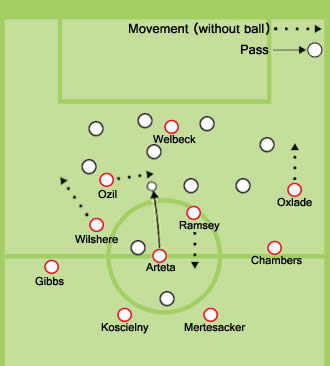Mesut Ozil found form of sorts for Arsenal on Saturday in their 1-1 draw with Tottenham, delivering a performance that showcased his usual understated subtlety, but one without producing the telling, final punch. He had one big opportunity at the start of the second-half, gliding into space on the right-hand side before receiving a neat pass from Jack Wilshere, but his shot was hit rather tamely at Hugo Lloris. By this time, Ozil was playing in his preferred position behind the striker as Arsene Wenger was forced to switch away from the 4-1-4-1 that saw Ozil start on the left following Aaron Ramsey’s injury.
The tactical reshuffle after the break didn’t inspire much of an upsurge in tempo; instead Arsenal fell a goal behind and though they equalised with plenty of time to spare, the performance overall, on Derby Day, just felt a little flat.
In this new system, Arsenal becomes a team without a principle conductor as such. Instead, there are many and though all got plenty of touches, neither could really get on top of a Spurs midfield which was organised and committed to spoil. Ozil, though, was probably the pick of the bunch, closely followed by Wilshere and indeed, it was the partnership between the two, particularly in the first-half, which caught the eye.
I say caught the eye because, for the first-time perhaps, there were visible signs that the switch to the 4-1-4-1 is not just the most rational way to shoehorn a number of princely conductors in – though shoehorning it is – or to play Jack Wilshere in his best position. Rather, there was a clear tactical plan that saw Wilshere fill in whenever Ozil vacated the left-flank thus switching the formation instantly into a 4-4-2. Indeed, in an interview with Huawei, Wenger says that his favourite system is one that is “capable of transforming from 4-3-3 to 4-4-2” and with a number of different combinations and partnerships available to him at any given time, the new system allows him to do that.
 There were other dynamics at play at the same that allowed the transformation to happen. Before the match, Wenger told the press that Ramsey needed to play deeper, and that’s what we saw more from him of, dropping back to help build the ball out and allowing Wilshere and Ozil to push forward. Also, on the other side was Alex Oxlade-Chamberlain, who selflessly acted as an outlet by hugging the line all the time. This had the added effect of opening up space in the centre to allow Arsenal to push players between the lines.
There were other dynamics at play at the same that allowed the transformation to happen. Before the match, Wenger told the press that Ramsey needed to play deeper, and that’s what we saw more from him of, dropping back to help build the ball out and allowing Wilshere and Ozil to push forward. Also, on the other side was Alex Oxlade-Chamberlain, who selflessly acted as an outlet by hugging the line all the time. This had the added effect of opening up space in the centre to allow Arsenal to push players between the lines.
Contrary to perception, partnerships are not necessarily about the amount of times two (or more) players combine with each other – though when they do it’s often telling. Generally, it’s about how you react when the team has possession; how you move off the ball to get into and create space, or from a defensive point of view, cover space. The most fluid systems are ones which are about little chain reactions: when one players moves, it activates the trigger for another to move into the space. Mesut Ozil and Jack Wilshere only needed so much as a glance to know when to switch places, as the GIF here shows.
Wilshere was selfless in this act, taking up wide positions when Ozil’s mood took him inside. As a result, we saw more effectiveness in Ozil’s movement as opposed to in previous matches where he’s played wide where often, opponents were able to double up on him.
Still, it’s hard to shake off that Ozil would be better off playing more frequently down the middle. His strength is as a provoker: trading innocuous passes then suddenly gliding into space. He does this actually, by going the other way – to the flanks – by creating overloads and then switching the direction of play with a quick pass or run. Indeed, his passes in the second-half, once he was switched to the middle, actually happened mainly on the left-flank (when curiously it seemed, everything after Arsenal had equalised, was happening on that side – as if there was a tilt on the Emirates pitch – with Alexis, Cazorla and Ozil all attracted to the flank).
Ultimately, this is the way Ozil operates. He sees the game as a picture within a picture, entering and departing each frame as he wills. Rosicky and Cazorla are different number 10s in this regard; more like extensions of the midfield who prefer to ferret and furrow than see the game as a mental flowchart, and as such are more suited to a wider role.
There is, nevertheless, science in playing a 4-1-4-1, especially in the big matches with Zdenek Zeman, the former Roma coach, saying that it’s the “most rational formation to cover the spaces.”
Certainly, the rotation that Wilshere and Ozil produced probably could not have been possible in a 4-2-3-1 without leaving gaps behind. It’s a shame, then, that injuries brought a premature end to the “experiment”. With Ramsey out for 6 weeks, Oxlade-Chamberlain looks like his most natural replacement. That, or move Ozil back to the middle…


